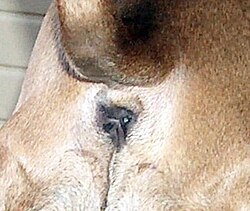
Back Anus Afrikaans Ano AN شرج Arabic ܛܝܙܐ ARC Cursu AST Jamaña Aymara Anal dəlik Azerbaijani Labot kan lubot BCL Анус Byelorussian Кутнічнае выйсьце BE-X-OLD
| Anus | |
|---|---|
 Anus of a dog | |
 Formation of anus in proto- and deuterostomes | |
| Details | |
| Precursor | Proctodeum |
| System | Alimentary |
| Artery | Inferior rectal artery |
| Vein | Inferior rectal vein |
| Nerve | Inferior rectal nerves |
| Lymph | Superficial inguinal lymph nodes |
| Identifiers | |
| Latin | anus |
| TA98 | A05.7.05.013 |
| TA2 | 3022 |
| Anatomical terminology | |
In mammals, invertebrates and most fish,[1][2] the anus (pl.: anuses or ani; from Latin, 'ring' or 'circle') is the external body orifice at the exit end of the digestive tract (bowel), i.e. the opposite end from the mouth. Its function is to facilitate the expulsion of wastes that remain after digestion.
Bowel contents that pass through the anus include the gaseous flatus and the semi-solid feces, which (depending on the type of animal) include: indigestible matter such as bones, hair pellets, endozoochorous seeds and digestive rocks;[3] residual food material after the digestible nutrients have been extracted, for example cellulose or lignin; ingested matter which would be toxic if it remained in the digestive tract; excreted metabolites like bilirubin-containing bile; and dead mucosal epithelia or excess gut bacteria and other endosymbionts. Passage of feces through the anus is typically controlled by muscular sphincters, and failure to stop unwanted passages results in fecal incontinence.
Amphibians, reptiles and birds use a similar orifice (known as the cloaca) for excreting liquid and solid wastes, for copulation and egg-laying. Monotreme mammals also have a cloaca, which is thought to be a feature inherited from the earliest amniotes. Marsupials have a single orifice for excreting both solids and liquids and, in females, a separate vagina for reproduction. Female placental mammals have completely separate orifices for defecation, urination, and reproduction; males have one opening for defecation and another for both urination and reproduction, although the channels flowing to that orifice are almost completely separate.
The development of the anus was an important stage in the evolution of multicellular animals. It appears to have happened at least twice, following different paths in protostomes and deuterostomes. This accompanied or facilitated other important evolutionary developments: the bilaterian body plan, the coelom, and metamerism, in which the body was built of repeated "modules" which could later specialize, such as the heads of most arthropods, which are composed of fused, specialized segments.
In comb jellies, there are species with one and sometimes two permanent anuses, species like the warty comb jelly grows an anus, which then disappear when it is no longer needed.[4]
- ^ Helms, Doris R.; Helms, Carl W.; Kosinski, Robert J.; Cummings, John C. (1997). Biology in the Laboratory With BioBytes 3.1 CD-ROM. W. H. Freeman. p. 36-12. ISBN 978-0-7167-3146-7.
- ^ Langstroth, Lovell; Libby Langstroth; Todd Newberry; Monterey Bay Aquarium (2000). A living bay: the underwater world of Monterey Bay. University of California Press. p. 244. ISBN 978-0-520-22149-9.
- ^ Chin, K.; Erickson, G.M.; et al. (1998-06-18). "A king-sized theropod coprolite". Nature. 393 (6686): 680. Bibcode:1998Natur.393..680C. doi:10.1038/31461. S2CID 4343329. Summary at Monastersky, R. (1998-06-20). "Getting the scoop from the poop of T. rex". Science News. 153 (25). Society for Science &: 391. doi:10.2307/4010364. JSTOR 4010364. Archived from the original on 2013-05-11. Retrieved 2009-04-24.
- ^ What is a warty comb jelly? | BBC Science Focus Magazine